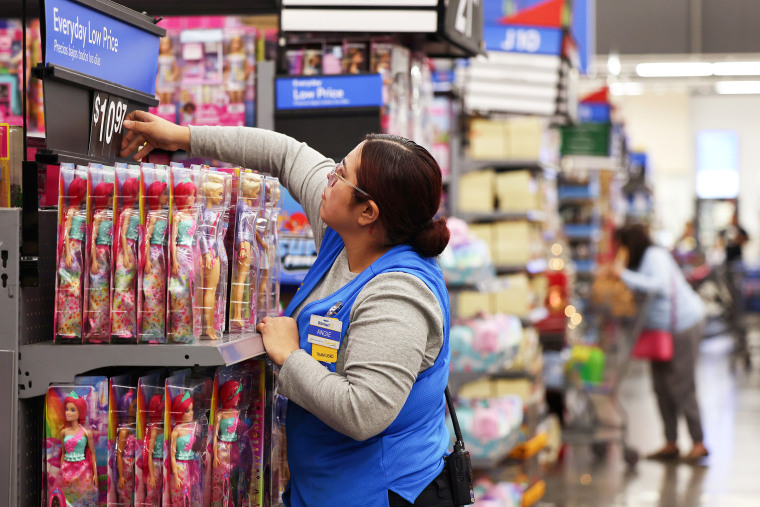WASHINGTON — Retailers have been pulling back on holiday hiring this season, announcing the fewest seasonal job openings since 2013 and nixing hiring perks like $3,000 sign-on bonuses, amid mixed signals over the strength of consumer spending.
Several major employers including the U.S. Postal Service and Macy’s have announced plans to take on fewer seasonal workers than last year, and other employers including Walmart have indicated they will be relying largely on their regular workforce to meet the increased demand.
The slowdown in holiday hiring from the prior two years fits with a larger cooling in the labor market. While unemployment remains low and wages have continued to tick up, competition for workers in retail, hospitality, warehousing and transportation has eased as companies have slowed hiring and layoffs have picked up over the past year. For workers who rely on the extra boost to their income around the holidays, that means fewer options and less competition on pay and benefits, industry analysts said.
“It feels like the labor market has really cooled,” said Andy Challenger, a senior vice president with employment firm Challenger, Gray & Christmas Inc. “The labor market is still tight, there’s still competition for workers, but it’s not like what we were seeing the last two seasons where the companies were not able to hire as many people as they would have liked.”
Companies have announced plans to hire 573,000 seasonal workers, down 60% from 2021 hiring levels and the lowest number since 2013, according to data from Challenger, Gray & Christmas. Retailers hired roughly the same number of workers in October as they did a year earlier and have been paring their workforce over the course of the year, announcing more than 72,000 job cuts through October, the highest number of cuts since 2020.
The National Retail Federation expects its members to add a similar number of workers as last year, which was significantly down from 2021, when companies were scrambling to rebuild their workforces coming out of the pandemic and holiday sales surged.
Macy’s said it will hire 38,000 seasonal employees for its Macy’s, Bloomingdale’s and Bluemercury stores, down from the 41,000 it said it planned to hire last year and the 76,000 workers it hired in 2021. Target and UPS will hire a similar number of employees as they have in the last several years.
Walmart, which hired 40,000 seasonal workers last year, said it has been building up its staff throughout the year and as of last month was fully staffed to handle the holiday influx without having to take on any additional holiday workers. Instead, the company plans to offer extra hours to its existing employees and will hire on a case-by-case basis if any store still needs extra workers, said Walmart spokesperson Anne Hatfield.
Bucking the trend is Amazon, which will be hiring 250,000 full-time, part-time and seasonal employees, a major increase over the 100,000 holiday employees it took on last year, and will once again be offering hiring bonuses worth up to $3,000 at some locations.
Driving the mixed hiring trends is an overall uncertainty about what the holiday shopping season will hold amid a wave of pressures on consumers, including rising interest rates on credit cards and mortgages, dwindling savings, the resumption of student loan payments and cooling yet persistent inflation. Consumer confidence fell to a five-month low in October.
“Companies are very worried about the outlook, and they’ve told us as much in many customer meetings,” said Julia Pollak, chief economist at ZipRecruiter. “They’ve been worried about workers exhausting their pandemic savings, rising interest rates on credit card debt and auto loans, rising delinquencies, the student loan restart.”
Retailers are also in a better position with their overall staffing going into the holiday season and have increased the use of self-checkouts and other self-service systems to cut down on their workforce needs, she said.
“Labor shortages have eased a lot, especially in industries like retail,” said Pollak. “That’s causing employers to no longer fear that they’re in this dogfight for talent where they need to move really quickly and aggressively.”
The share of employers offering hiring bonuses to their seasonal workers has gone from 8.3% in 2020 to 2.5% so far this year, according to data from ZipRecruiter.
At the same time, consumers have continued spending as unemployment has remained low. U.S. GDP grew nearly 5% last quarter, the biggest quarterly gain since late 2021, with nearly half of the growth coming from consumer spending.
The National Retail Federation estimates consumers will spend 3% to 4% more this year than they did last year — the slowest rate of growth since 2019 after several years of surging holiday spending, but in line with pre-pandemic levels.
“We know consumers are becoming more cautious in the face of inflation and rising interest rates and the impact of monetary policy decisions,” said Matthew Shay, president of the National Retail Federation. “And yet those consumers continue to spend.”

